Home | Research | Publications | People
____________________________________________________
______| |_______
\ | Website under construction. Not yet final. | /
\ | Please stay tuned. | /
/ |____________________________________________________| \
/__________) (__________\
Ferienakademie 2024 - Course [10]: Lattice Boltzmann Methods meets Solid Mechanics
This is the official webpage of the Ferienakademie 2024 course Nr. 10 on Lattice Boltzmann methods and solid mechanics, organized by Prof. Barbara Wohlmuth (TU Munich) and Prof. Holger Steeb (University Stuttgart). The following sections will give a brief overview over possible applications in the context of Lattice Boltzmann methods (LBM) and solid mechanics that will be considered in the course, both from a theoretical as well as practical / implementation based perspective.
The first main goal of this course is to get familiar with the fundamentals of continuum mechanics that are the foundation of fluid- and solid-mechanics. Typically for the underlying partial differential equations no analytical solutions do exist in real live situations such that numerical schemes are required to obtain (approximate) solutions. In solid mechanics simulations are often based on the Finite Element method (FEM), while (coming from gas-dynamics) the Lattice-Boltzmann method is an attractive alternative, especially for transient flow simulations. The method is comparably simple to understand and highly parallelizable in modern computing frameworks. However, in complex multiphysics scenarios interaction with other specialized simulation- and solver-technologies is essential. This course aims to bring together these different fields and topics guiding you through the whole "simulation-pipeline" from the abstract theory in a nutshell, the mathematical modeling of concrete applications up to the efficient implementation of the respective solution schemes and their numerical analysis. If you are interested in applied mathematics, are not hesitant to also dive into an unknown field of engineering/chemical/natural science application combined with some coding/programming affinity, then this course is the right place for you and we would be happy to be able to welcome you!
Links to course-relevant topics and webpages:
- Ferienakademie 2024 courses - Organizatorial: Backlink
- ...
Fluid mechanical benchmarks
As initial benchmarks to test a new solver-technology such as LBM, classical flow configurations such as the lid-driven cavity or the Carman-vortex street are used. For such cases the expected flow patern is known and one tests whether the numerical scheme can indeed reproduce the desired pattern. Often such benchmarks use simple geometries or simplifying conditions making them ideal starting candidates. However, often they are (at least partially) inspired from actual applications or situations that can be recovered by further adaptions of the benchmark.
- Lid-driven cavity: Think of a river flowing over an even river-bed with some cuboid being removed from that river bed leaving a hole in there. Of course, water will start to fill the cavity, the questions is, which kind of flow-pattern will emerge in there, driven by the steady flow of the river on its top surface. The answer is that some vortex will form and circulate within the cavity with details depending on the driving flow's velocity, the fluids viscosity etc.
A realistic scenario comparable to the benchmark could be bloodflow through an artery where an aneurysm has formed on the side of the vessel, also experiencing some vertex formation.
- Carman vortex-street: The Carman vortex-street is another classical benchmark, where a cylinder (sphere in 2D) is placed as an obstacle within a flow channel with a given inflow profile. The fluid has to move around the obstacle leading to a so called dynamic vortex shading.
If the kind of artifical cylinder / sphere is replaced by something more complex as for example the cross-section of an airplane wing, this benchmark can be quickly developed into the direction of a drag- and lift-force analysis tool for different wing-configurations.
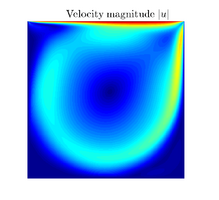
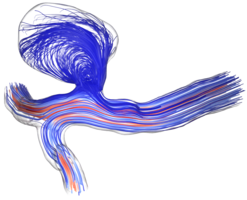
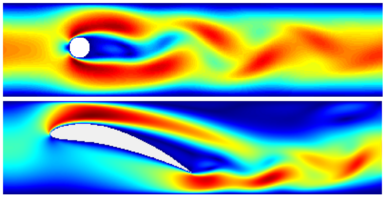
Coupled flow-processes
Once pure flow processes as from the aboves benchmark cases are implemented, a next step is the coupling of further components to the flow such as thermal quantities (e.g. the local temperature of the fluid) or chemical compounds that are transported by the flow. Within the LBM such additional flow-components can be coupled to the flow astonishingly easily opening the door towards (multi)physics simulations and applications such as:
- Heat convection cells: A confined fluid within a box that is heated at the bottom (and cooled on the top)... just think of a pot of water you are heeting on your stove. Due to temperature, hot water will start to rise pushing down colder layers of water leading to quite interesting flow patterns triggered by temperature differences within the fluid.
Potential real live applications arise from athomspheric flow simulations as in your daily weather forecase, combustion engines or chemical/industrial manufacturing processes.
- Dissolution processes: Another addition to pure flow is the transport of chemical species. Think of a drop of ink that is inserted into a flow. The ink will move together with the flow while also diffusing more and more until it is barely visible anymore. Similar processes happen for example with drugs being injected into the bloodstream of the arteriovenous system or the errosion of a solid material within steady flow conditions.

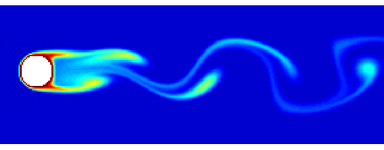
Porous Media Flow
As a third example for LBM-based fluid mechanics, porous media flow is something everybody can relate to from daily activities... you might just not yet know from where. If you think of your daily espresso being brewed in one of those pressure coffee machines, water is pressed with high pressure through grained coffee beans / powder. The high pressure is (among aromatic reasons) necessary for the water to find its way through the coffee in reasonable short time, otherwise you would wait pretty long for your coffee because the densely packed powder particles, a (tasty) "porous medium" inhibits the straight forwards fluid flow. Similar applications arise for example in ground water flows through different layers of porous sands and gravel or again in modern medicine, where endovascular devices are inserted into aneurysms in order to hinder the blood flow therein. The understanding and accurate simulation of the slowing processes of porous media is a topic of active research with a growing amount of use cases for LBM.
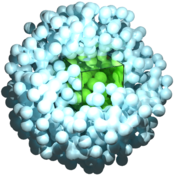

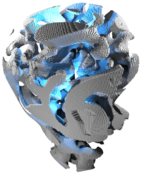
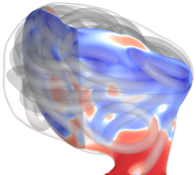
Solid Mechanical Topics and Aspects
____________________________________________________
____| |_______
\ | Work in progress, to be added soon ... | /
\ | please stay tuned. | /
/ |____________________________________________________| \
/__________) (__________\